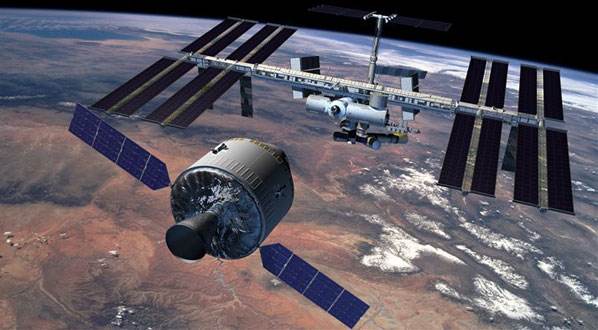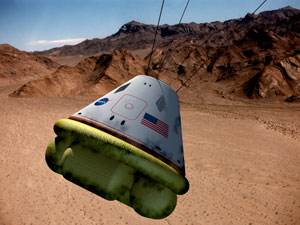
By Jeff Foust
The U.S. is leaving Earth orbit, but skeptics ask: Is pulling from the past compromising the future?
When President Bush unveiled the Vision for Space Exploration in January 2004, he offered only the most basic future milestones: completing the International Space Station by 2010; introducing a new spacecraft, the Crew Exploration Vehicle (CEV), by 2014; and returning humans to the Moon by 2020. NASA was left with the task of developing the plan that would achieve those goals.
While people at NASA and in the aerospace industry had been working hard on various concepts for sending humans
back to the Moon, those efforts were ratcheted up a notch with the arrival of new NASA Administrator Michael Griffin in April. Dissatisfied with the progress to date, Griffin had the agency’s exploration office carry out a 60-day study to develop a more detailed plan for the return to the Moon, with an emphasis on the key components-including spacecraft and launch vehicles-needed for the plan to succeed. The Exploration Systems Architecture Study (ESAS), released by NASA on September 19, offers the most detailed explanation to date of how to turn the Vision for Space Exploration into reality.
Something Old, Something New
When America first sent astronauts to the Moon in the 1960s, it had to start from scratch, developing brand-new spacecraft and launch vehicles that pushed the cutting edge of aerospace technology of the day. The ESAS plan reflects a different approach: Rather than starting from scratch, NASA is using a combination of designs and hardware from the Shuttle program, some of which date all the way back to Apollo.
At the heart of the architecture is the CEV [later named Orion]. The CEV strongly resembles the Apollo spacecraft, with a conical crew module attached to a cylindrical service module. It is not simply an Apollo replica, however; with a diameter of 5.5 meters, the CEV will be able to accommodate up to six astronauts on missions to Earth orbit, to the Moon and even to Mars. The CEV will be powered by solar panels, rather than the fuel cells used on Apollo, and is designed to be reusable: NASA hopes to fly each CEV up to 10 times, replacing just the heat shield after each flight.

NASA plans a phased development of the CEV. After a few years of unmanned suborbital and orbital test flights, the Block 1A CEV will begin human missions to the International Space Station in 2011, carrying three to six passengers. (A Block 1B version, which replaces the crew with 3,500 kilograms of cargo, will also service the ISS.) Later in the decade, NASA will introduce a Block 2 version of the CEV with an enlarged service module, designed to carry four astronauts to the Moon. A Block 3 version capable of supporting six people on a mission to Mars is already on the drawing board.
To launch the CEV, NASA will develop a new launch vehicle. “New” may be too strong a word, though, since the “crew launch vehicle” (NASA has yet to announce an official name for the rocket [later named Ares I]) will be comprised largely of existing components. The lower stage will be a four-segment solid rocket booster of the type used to launch the Space Shuttle, while a new upper stage will use a Space Shuttle Main Engine (SSME), fueled by liquid hydrogen and liquid oxygen. The rocket, which stands nearly 90 meters high, will be able to put about 25 metric tons into low Earth orbit (LEO), about the same capacity as the Delta 4 Heavy.
The same approach is being taken for the development of a new heavy-lift launch vehicle required for missions to the Moon. This rocket (also not yet officially named [later named Ares V]) will feature a first stage derived from the Shuttle’s external tank, with five SSMEs mounted on the bottom. Attached to either side of the first stage will be two five-segment solid rocket boosters, extended versions of the ones used to launch the shuttle. The result is a rocket that is 109 meters tall — just a few meters shorter than the Saturn 5 — and is capable of placing 125 metric tons into LEO.

This heavy-lift vehicle will be used to launch two key components. One will be the Lunar Surface Access Module (LSAM), a lunar module designed to carry four people between lunar orbit and the surface. The other will be the Earth Departure Stage (EDS), an upper stage powered by two J-2S engines — modified versions of the J-2 engines used on the second and third stages of the Saturn 5 — that will propel the CEV and LSAM to the Moon.
As currently envisioned, each lunar mission will feature two launches: one using the heavy-lift vehicle carrying the EDS and LSAM, followed by a crew launch vehicle carrying the manned CEV. Once in orbit, the CEV will dock with the LSAM and EDS. The EDS will then fire its engines to put the spacecraft on a lunar trajectory before being jettisoned. At the Moon the LSAM (rather than the CEV, as was the case with Apollo) will fire its engines to put the spacecraft in orbit. The crew will transfer to the LSAM and descend to the lunar surface, leaving the CEV unmanned in lunar orbit. Once their mission is done, the crew will return to the CEV using the ascent stage of the LSAM, just as with Apollo; the LSAM will then be jettisoned and the crew will return to the Earth in the CEV, parachuting to an airbag-cushioned landing at Edwards Air Force Base in California or elsewhere in the western United States.

The first lunar missions, scheduled for 2018, will be relatively short: no more than a week. Over time, however, NASA plans to extend the missions as it builds up experience and infrastructure on the lunar surface. By 2022, though, crews will spend up to six months on the surface at a time as NASA develops a permanent lunar outpost, most likely in the south polar regions of the Moon where deposits of water ice may exist.
Apollo Redux?
If you think this sounds a lot like an Apollo mission, you’re right, and even NASA is willing to admit that the program borrows generously from the 1960s program. “We have very similar requirements to Apollo,” explained Doug Cooke, deputy associate administrator for exploration at NASA. “The Apollo guys did a pretty good job.”
While such an approach helps reduce the technical risk and complexity compared to starting from scratch, the fear is that the new exploration program may look too much like Apollo, in the eyes of the public. That was the concern some expressed in the days after NASA released the ESAS report, particularly after Administrator Griffin went so far as to call this proposal “Apollo on steroids.”
“The retro feel of the exercise is somehow disappointing,” concluded an editorial in the San Francisco Chronicle shortly after the release of the ESAS report. “For the average American paying an estimated $104 billion to get back to the moon in several years longer than it took after President John F. Kennedy set the goal for the 1960s, there may be a letdown in the realization we have advanced no farther than the 1969-72 destination in space travel.”
That impression, coupled with the program’s price tag-which Griffin estimates to be $104 billion over 13 years- could cause problems in Congress. Just days after NASA unveiled the exploration plan, the Republican Study Group, a caucus of fiscal conservatives in Congress, unveiled “Operation Offset,” a proposed list of spending cuts designed to pay for the costs of hurricane relief. One of its biggest suggestions: canceling the entire exploration program, saving an estimated $44 billion over 10 years.
Griffin and others have tried to emphasize that this is a “go as you pay architecture” that will be driven by the budget, and that the plan fits into NASA’s overall budget, adjusted for inflation, through the end of the next decade. “The space program is a long-term investment in our future,” said Griffin. “We must deal with our short-term problems while not sacrificing our long-term investments in our future. When we have a hurricane, we don’t cancel the Air Force, we don’t cancel the Navy, and we’re not going to cancel NASA.”
One way to alleviate those concerns, and to differentiate this new plan from Apollo, is to involve other nations in the effort. Since the president’s original announcement about the Vision for Space Exploration, NASA has cited international cooperation as one of the program’s key aspects. NASA officials see a potential role for other nations building components of the system, from the EDS to components of the CEV or LSAM, depending on their level of interest. “We need to understand where their interests are and where they fit,” said Cooke.
However, to date there has been little movement on exactly how other nations can participate. “We really are serious about international cooperation; the challenge always seems to be the timing,” said Mark Borkowski, director of NASA’s robotic lunar exploration program. “We are frankly disappointed that we’re not able to define clearly more international opportunities.”
A Vision of Settlement
Another key difference between the new exploration program and Apollo is its ultimate goal. For Apollo, the goal was straightforward: Beat the Soviet Union to the Moon. Apollo succeeded, but failed to create any significant lasting infrastructure that would allow humans to live and work on the Moon. The Vision for Space Exploration is different. The program — as carried out by ESAS — is not driven merely by competition to reach the Moon; instead, it aims to create an infrastructure that can be used not just to send humans back to the Moon, but to establish a permanent presence there. It also lays the groundwork for human missions to Mars, which Cooke said could be carried out as early as 2030 under the plan.
That emphasis can be seen in a number of elements of the ESAS program, from the adaptability of the CEV for missions to the Moon and beyond to the development of a heavy-lift vehicle. It’s also present in the little details, like the development of an engine for the CEV’s service module and the ascent stage of
the LSAM that will use liquid oxygen and methane, a propellant combination not previously used on American manned spacecraft. Why methane? NASA is looking ahead to missions to Mars, where methane can be produced in situ, rather than be hauled all the way from Earth.
That emphasis is also present in Griffin himself, who sees the exploration plan as the beginning of the eventual settlement of the solar system-a necessity, he believes, if humanity is to survive. “The goal isn’t just scientific exploration…. It’s also about extending the range of human habitat out from Earth into the solar system as we go forward in time,” he told The Washington Post in September. “I’m talking about that one day, I don’t know when that day is, but there will be more human beings who live off the Earth than on it. We’ve got places that humans will go, not in our lifetime, but they will go there.”
Jeff Foust is a launch industry analyst with the Futron Corporation of Bethesda, Maryland, and publisher of The Space Review, a weekly online space publication, and of Spacetoday.net, a space news aggregator. He also operates the Space Politics weblog.







